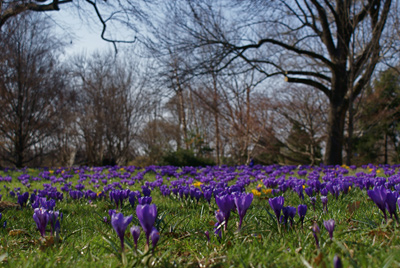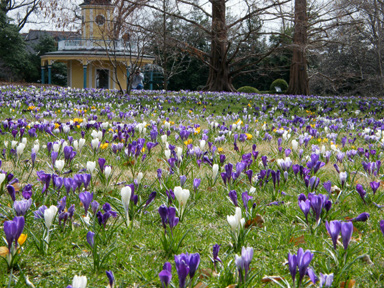Learning from Our Customers: Growing Crocus in Lawns

We love crocus and plant them everywhere — except in the lawn. That’s because in our experience the only lawns they ever thrived in were (a) in photos, (b) in Europe where lawns are often as short as putting greens, or (c) in thin, scruffy lawns shaded by trees — and only Crocus tommasinianus seemed truly happy there.
But eventually the enthusiastic claims of some other bulb-sellers made us start to wonder if maybe we were missing something. So we asked our newsletter readers (including a bulb expert at the Missouri Botanical Garden), and they responded big-time. We learned a lot, and though we won’t tell you that all crocus will thrive in all lawns, there are more possibilities than we thought — if you know what you’re doing.
So here’s the evidence and advice. See what you think, maybe experiment with a handful in your own lawn, and if you’d like to add to the discussion, email us at help@oldhousegardens.com.
First the Bad News
As we expected, several readers told us that crocus in their lawns had failed.
“I took the advice of one of your competitors and planted a smiley face in my lawn with yellow and purple crocuses,” wrote Carol Bradford of zone-5/6 Syracuse, NY. But “no more lawn crocuses for me. First of all, it takes hundreds of bulbs to make a good face — not cheap. Secondly, they lasted maybe 2-3 years, compared to the crocuses in my flower beds, some of which are going on 25 years.”
Across the country in zone-5/6 Spokane, WA, Jean Hollar also reported sad results. “Years ago we seeded in a new front lawn and planted crocus at the same time. They were glorious that next spring, and for three or four springs afterwards, though each year they were less so. We found that we could not leave the lawn unmowed until all of the foliage had matured, and so we always mowed off some of the yet-green leaves. I think the grass simply became too competitive as well. Where it’s less thick, two or three crocus have persisted, but all the rest disappeared within a few years.”
Lawn overwhelmed the crocus in Nancy Crowell’s yard, too. “Unfortunately, in our wonderful, wet climate [in zone-8 La Conner, WA], the lawn grew too fast — faster than the crocuses! So we ended up cutting them before they could bloom. Tragic, really, but the grass was just too vigorous.”
In dry, zone-6/7 Boise, ID, the species crocus in Margaret Lauterbach’s lawn faced a different problem: squirrels. “They never did find all of them,” she wrote, “but in about five years nearly all of my crocus were gone.”
But There’s Good News, Too
Happily, other readers reported great success.
A retired farmer in zone-5 Ionia, MI, told us: “Six years ago I planted daffodils and crocus in lawn grass beneath a long row of mature basswood trees. I postpone mowing the grass until the daffodil foliage starts to yellow in June. Grass is looking unkempt by then but we’re reluctant to deprive bulb-foliage of the chance to mature. So far they’re all thriving!”
AlJean Mackenzie of zone-6 Royal Oak, MI, reported enthusiastically: “Yes, yes, yes! By all means! Plant those crocus in your lawn! I did 25 years ago and some are still blooming every spring. They are ‘Dutch’ crocus, not species, and they grow mostly in part shade, in lawn that we never use chemicals on because of the children, pets, and wildlife. They are getting sparse now, but 25 years is a long time for these rugged little guys.”
And Mark Biggus of zone-5/6 Lockport, IL, practically crowed: “The lawn is the ONLY place I recommend planting crocus, as they get lost elsewhere. My father planted crocus in his lawn 35 years ago and they have spread to a sprawl that is nearly 1/2 acre and is amazingly impressive in the early spring. I am carrying on this tradition at my new home, and in three short years the lines of my planting have blurred and every spring I am greeted by a carpet that is spreading across my front lawn. Here in Chicagoland crocus do fabulously, especially in the lawns. Drive through our neighborhoods any early March day and you will find them in lawns everywhere!”
Key Requirement #1: Choose the Right Crocus

any readers told us that small, early-blooming species crocus did well in their lawns, especially Crocus tommasinianus, affectionately known as tommies. The traditional, larger, later-flowering “Dutch” crocus, C. vernus, seem to have a harder time in lawns, though see the advice below from the Missouri Botanical Garden.
“I’ve seen old lawns in the [zone-8] Seattle area covered with crocus,” wrote Deirdre Zema. “It seems to work best for the earliest bloomers. The later bloomers get mowed too soon to do well long term. In the lawn of my 1916 Craftsman bungalow, the crocus are in full sun, but the lawn is kind of thin in that area. This seems to be true of the other lawns I see them in, too.”
Back east in zone-7/8 Arlington, VA, Julia Tanner wrote: “Here near the Potomac River, many lawns (including ours) sport crocus that come back year after year. Perhaps it is climate; perhaps it is the lack of manmade chemicals on our small yard; goodness knows I’d be surprised if the secret is the clay soil. The lawns range from full sun to a fair amount of shade. They’re not very thick, for the most part. The crocus varieties are at least C. tommasinianus and possibly C. chrysanthus as well.” (Opinions on C. chrysanthus are mixed; see below.)
“Squirrels and other animals sometimes eat the [traditional] ‘Dutch’ crocus in our neighborhood,” Julia added, “but the lawn crocus rarely if ever seem to be consumed. Perhaps the turf deters the critters, or perhaps the ‘Dutch’ crocus just taste better.”
David Enoch of zone-6 Warren, OH, had a similar report: “Crocus are a delicacy on the squirrel and chipmunk diet, and any I have planted in flower beds seem to disappear after a few years. The ones I’ve casually buried here and there in the lawn, on the other hand, come up and bloom nicely every year, though with no noticeable increase.”
From New England, Bill Andreas wrote: “There are several patches of what I’d guess are Crocus tommasinianus happily growing in the front lawns of several of the older farm houses here [in zone-6 Sudbury, MA]. One patch is at least 15 feet in diameter forming a nice lavender lawn. No one knows when they were planted (‘they came with the house’ is what most people say), so in at least one case they’ve been there for at least fifty years. In all cases, they are happily growing in somewhat thin lawns which are partially shaded by deciduous trees.” As for C. vernus, he added, “While there are patches of larger-flowered crocus persisting in other areas, none of those seem to be established in lawns.”
Helen Lord moved to England eight years ago, but she still reads our newsletter and offered this perspective from abroad: “Lots of older homes, parks, and even old churchyards here have crocus growing by the thousand in the lawn. Most seem to be species crocus, particularly Crocus tommasinianus, as well as Crocus vernus and its subspecies albiflorus. They grow happily in scruffy, thin lawn and in lightly shaded lawn areas under high trees. I suspect benign neglect allows them to flourish since the turf is far from the thick sod that is such a desired element in many American gardens.”
Tommies Will Even Plant Themselves in Lawns
Not all crocus spread by seed, but some do so eagerly. Here at Old House Gardens, for example, the striking C. tommasinianus ‘Pictus’ planted at the base of a hydrangea has sown itself into the surrounding lawn, and this seems to be common.

Janet Cushman of zone-6/7 Oak Ridge, TN, wrote: “Though I haven’t planted crocus in lawns, I’ve had Crocus tommasinianus in a flower bed above a low retaining wall seed itself into the lawn below. I first noticed two flowers about five years ago, and they’ve slowly increased to about eight scattered plants. I welcome the delicate little show each spring, but I’ve never given them any special care. They don’t get much sun, and the thin lawn over hard clay is mowed, crocus and all, at three inches.”
In zone-6 Cincinnati, OH, tommies have seeded themselves much further afield. Linda Wallpe reported: “Here crocus do just fine planted in grass. Many years ago a neighbor planted some C. tommasinianus in grass on a small rise across the street. They have increased to fill in that corner of their yard and have traveled across the street to bloom in a corner of my flower bed — but not in our lawn, which is mostly that dreadful, crabgrass-like zoysia grass.”
In zone-7 Farmville, VA, David Folkes actually prefers the self-sown crocus in his lawn. “I’ve not planted them there myself,” he wrote, “but I’ve had a few of the smaller specie crocus seed themselves into the thin, surrounding lawn from an adjacent flower bed. I actually like the crocus better in the lawn where they have to compete with the grass and don’t make such thick clumps as they do in the bed. Mowing probably holds them back, too. In the flower beds the clumps can get so big and thick that they crowd out other plants and look messy when the foliage is maturing.”
Key Requirement #2: “Old-Style Lawn Care”
As you may have noticed, another key to success with crocus in the lawn is to avoid mowing their foliage so it can recharge the bulbs.
Tom Platt of zone-6/7 Hamden, CT, says there’s at least two ways to do that. “I have been successful with the species crocuses I have planted in two lawns. They have persisted long enough now in my front yard to be considered a permanent fixture. Indeed, my Old House Gardens order for this fall includes some C. tommasinianus ‘Pictus’ for my lawn.
“Some caveats, however: I mow my lawn at the highest possible setting, around 3 1/2”. This is a great deal higher than most people like to cut their lawns. Although my basic motivation for this is to crowd out weed seedlings and to resist drought with bigger grass plants, I’m assuming it also allows more crocus leaves to remain as well.
“I plant only the very small, very early types of crocus in the lawn, such as cultivars of C. tommasinianus and C. chrysanthus. The [traditional] C. vernus types are simply too large and too late to do well in a lawn, plus their foliage is so big and coarse that it looks ugly among the grass blades.
“I also seem to be having some success with crocus in a very different type of lawn at my neighborhood library branch where I volunteer. The only attention this care-starved lawn gets is a periodic close cutting, which is infrequent and starts late. So as for allowing crocus plants to complete their growth cycle, there seems to be more than one way to accomplish it.”
And crocus typically do better in lawns that are thinned by too little sunlight, water, or nutrients. As Bill Andreas of zone-6 Sudbury, MA, explains, “old style lawn care” is best for crocus: “I’d say that the smaller flowered crocus can be quite successfully planted in a lawn that isn’t too thick in partial shade. Of course, when you have bulbs growing in the lawn, you do have to take care during ‘spring clean up’ not to rake, aerate, etc., where they live, and you may need to defer mowing in that area. In other words, apply ‘old style lawn care’ which consists mainly of ignoring the lawn, occasionally remembering to fertilize it with some nice manure and convincing a neighborhood lad to give it a weekly mow in the rainier part of the summer (for a handsome fee).”
Planting crocus in low-maintenance buffalo grass works, too, says, Susan Elder of Waynesboro, VA. “When I lived in New Mexico, I planted crocuses in a buffalo grass lawn that wasn’t mowed until mid-summer, and they did well there. Buffalo grass grows only about 6 inches tall, so it doesn’t have to be mowed if you don’t want to. I did have to mow it very low in late fall so the crocuses would show up when they bloomed in spring, and it didn’t green up until late May. The only problem was I had to carry buckets of water all winter for the crocus. My outside hose was always frozen then, and we got very little moisture from the sky ever. But despite the work, I loved my ‘crocus lawn’!”

Landmark Crocus Lawns
Two crocus lawns that our readers told us about are so remarkable that people flock to see them every spring.
Theresa Pepin of zone-6/7 Knoxville, TN, wrote: “The lawn of a historic home here (behind a beautiful curving brick wall) is such a phenomenon when the crocus bloom that we call it The Blue Lawn. They do very well there, indeed. The owners do not use any herbicide, of course. Some years it is more spectacular than others, but in February every gardener in town is very grateful for the sight.”
And Laverne Boehmke of zone-6/7 Saint Louis, MO, tipped us off to a celebrated public planting: “I have never planted crocus in my lawn, but each spring I enjoy the Crocus Lawn at the Missouri Botanical Garden in Saint Louis. You might ask them how it is cared for. I know they leave the grass grow for awhile and have to put out a little sign saying why it isn’t being cut.”
In Summary: Expert Advice from the Missouri Botanical Garden
We took Laverne’s advice and called our friend Jason Delaney, senior outdoor horticulturist at the Missouri Botanical Garden, one of the world’s premier public gardens. Here’s what he told us about their glorious Crocus Lawn:
1. Choose the right site. The MoBot Crocus Lawn is planted in the bright shade of mature, deciduous trees. The trees help keep the soil drier and the lawn thinner, both of which are advantageous for the crocus.
2. Plant the right crocus. Not surprisingly, Jason endorsed C. tommasinianus, including its named forms such as ‘Ruby Giant’. “Tommies are the most squirrel-resistant,” he said, probably because they have alkaloids in their corms that other crocus lack.
3. Mow VERY late. MoBot doesn’t mow their lawn till surprisingly late — mid-July, Jason told us, and some years not at all. This gives the crocus foliage plenty of time to mature completely and build up the corms for future years.
4. Don’t water. The MoBot crocus lawn is never watered. But don’t forget that annual rainfall varies widely across the US — St. Louis gets a lot less than Boston but much more than Denver — and that all bulbs need water when they’re in active growth, from fall (when they start new roots) through bloom.
5. Don’t use weed-killers. Don’t fertilize. Don’t aerate. In other words, give your crocus lawn “old-style” lawn care (see above). Anything that kills weed sedges (which grow from corms) will also kill crocus, Jason explained. Grass that’s well-fed can out-compete crocus, and aerating runs the risk of damaging corms.
6. Plant more. We’re not kidding. Jason told us that MoBot plants an additional 5,000-10,000 corms in their Crocus Lawn every fall.
So now you know as much as we do. Thanks to everyone who helped make this page possible. Hopefully it will inspire and guide you in planting a long-lived, ever-more-beautiful crocus lawn of your own. Have fun, and keep us posted!












